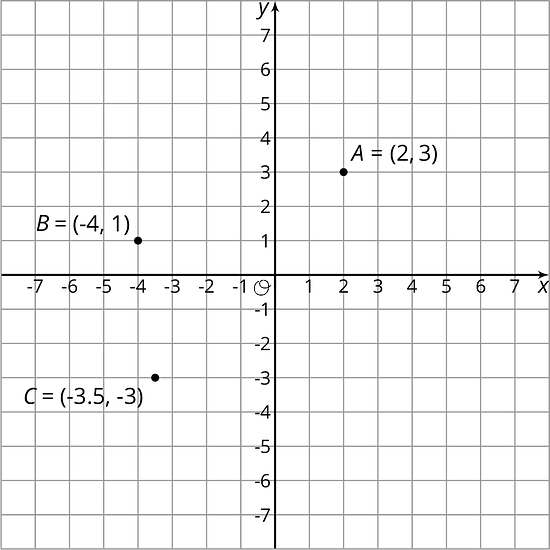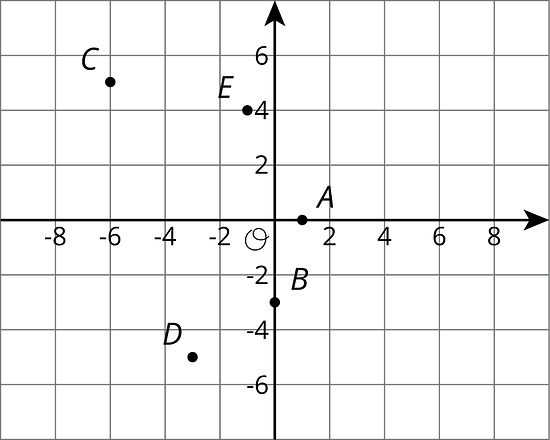Lesson 11Points on the Coordinate Plane
Let’s explore and extend the coordinate plane.
Learning Targets:
- I can describe a coordinate plane that has four quadrants.
- I can plot points with negative coordinates in the coordinate plane.
- I know what negative numbers in coordinates tell us.
11.1 Guess My Line

-
Choose a horizontal or a vertical line on the grid. Draw 4 points on the line and label each point with its coordinates.
-
Tell your partner whether your line is horizontal or vertical, and have your partner guess the locations of your points by naming coordinates.
If a guess is correct, put an X through the point. If your partner guessed a point that is on your line but not the point that you plotted, say, “That point is on my line, but is not one of my points.”
Take turns guessing each other’s points, 3 guesses per turn.
11.2 The Coordinate Plane
-
The colored points on the coordinate plane are like targets. Hit each point by entering its coordinates as an ordered pair in the Input Bar, like this:

- What do you notice about the locations and ordered pairs of , , and ? How are they different from those for point ?
-
Plot a point at . Label it . Plot another point at . Label it .
-
The coordinate plane is divided into four quadrants, I, II, III, and IV, as shown here.
- In which quadrant is located? ? ?
- A point has a positive -coordinate. In which quadrant could it be?
11.3 Coordinated Archery
Here is an image of an archery target on a coordinate plane. The scores for landing an arrow in the colored regions are:
Yellow: 10 points Red: 8 points Blue: 6 points Green: 4 points White: 2 points
Name the coordinates for a possible landing point to score:
1. 6 points 2. 10 points 3. 2 points 4. No points 5. 4 points 6. 8 points
Type the coordinates for each point in a separate line, using parentheses. Like this:

Are you ready for more?
Pretend you are stuck in a coordinate plane. You can only take vertical and horizontal steps that are one unit long.
- How many ways are there to get from the point to if you will only step down and to the right?
- How many ways are there to get from the point to if you can only step up and to the right?
- Make up some more problems like this and see what patterns you notice.
Lesson 11 Summary
Just as the number line can be extended to the left to include negative numbers, the - and -axis of a coordinate plane can also be extended to include negative values.

The ordered pair can have negative - and -values. For , the -value of -4 tells us that the point is 4 units to the left of the -axis. The -value of 1 tells us that the point is one unit above the -axis.
The same reasoning applies to the points and . The - and -coordinates for point are positive, so is to the right of the -axis and above the -axis. The - and -coordinates for point are negative, so is to the left of the -axis and below the -axis.
Glossary Terms
The coordinate plane is divided into 4 regions called quadrants. The quadrants are numbered using Roman numerals, starting in the top right corner.
Lesson 11 Practice Problems
-
Graph these points in a coordinate plane: , , , .
-
Connect all of the points. Describe the figure.
-
Write the coordinates of each point.

These three points form a horizontal line: , , and . Name two additional points that fall on this line.
One night, it is warmer in Tucson than it was in Minneapolis. If the temperatures in Tucson and Minneapolis are opposites, what is the temperature in Tucson?
-
Noah is helping his band sell boxes of chocolate to fund a field trip. Each box contains 20 bars and each bar sells for $1.50.
- Complete the table for values of .
boxes sold money collected 1 2 3 4 5 6 7 8 - Write an equation for the amount of money, , that will be collected if boxes of chocolate bars are sold. Which is the independent variable and which is the dependent variable in your equation?
- Write an equation for the number of boxes, , that were sold if dollars were collected. Which is the independent variable and which is the dependent variable in your equation?
- Complete the table for values of .
Lin ran 29 meters in 10 seconds. She ran at a constant speed.
- How far did Lin run every second?
- At this rate, how far can she run in 1 minute?